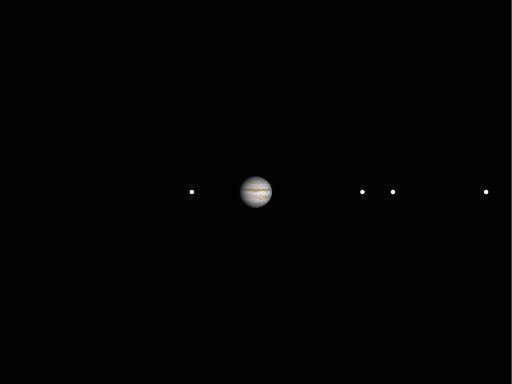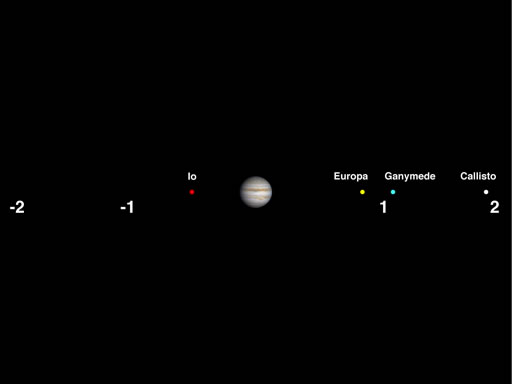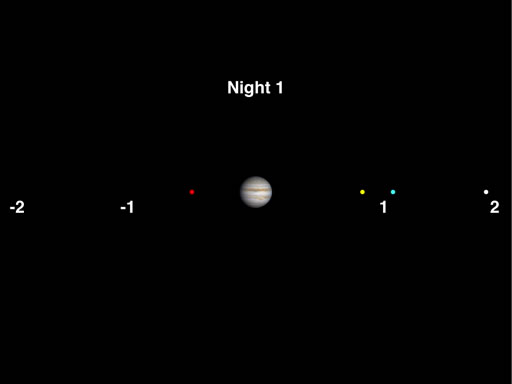The Galilean Moons of Jupiter
Galileo also looked at Jupiter.
DIGITAL EFFECT: Telescopic Jupiter
Scale the Mars image down, and scale up a modest telescopic view of Jupiter with the four Galilean moons visible.
VISUAL 6 (still): Jupiter and 4 Moons

He saw the planet Jupiter with four small objects in a line near it. Galileo thought the objects were stars, but when he observed Jupiter on subsequent nights, those “stars” appeared in different places. This was quite upsetting (and intriguing), since patterns of other stars never change relative to one another from night to night. Galileo kept careful records of the positions of Jupiter’s companion “stars.”
VISUAL 7 (still): Galileo’s Notes
[Fade on a copy of Galileo’s notes, from his observations of Jupiter’s moons in 1610.]

Don’t worry if you can’t read the words. It’s written in Italian. Each night Galileo recorded the positions of Jupiter (use arrow to indicate), and its 4 companion “stars.”
Do you think they are really stars? [No.]
What else could they be? [Moons!]
Galileo determined that they were moons. Let’s see why. Let’s watch Jupiter and its moons for a few nights just as Galileo did. Here is some astronomical note paper for you to note the changing positions.
[Hand out a “Tracking Jupiter’s Moons” sheet to each person.]
One sticky problem Galileo had was trying to tell which “star” was which. Let’s make our job easier by doing something Galileo could not: color each moon a different color.
For this “Galilean Moons of Jupiter” section you may want to allow for random access of the images, in case someone in the audience needs to see a previous night (e.g., going back to see Night 5 when viewing Night 7). But normally that’s not necessary.
VISUAL 8 (still): Jupiter and Moons Color Coded
[Fade up a similar image to the telescopic view of Jupiter above, but with the moons individually color-coded, labeled, and with distance markers on the image.]

Let’s further simplify our task by specializing: look at only one moon at a time.
Divide the class into four groups and assign each group one “star” to keep track of. Point out the color and name of each moon. Also point out the numbers that indicate distance from Jupiter in millions of miles. For younger classes (grades 1-2), do not hand out paper. Do not divide the class into groups. Have the entire class observe one moon at a time.
VISUAL 9 (still): Tracking Night 1
[Bring up the view of the moons on “Night 1” of the “Galilean Moons of Jupiter” tracking activity.]

This is the same image as in “Moon Labels”, but with the labels removed for easier reading.Here is our view for our first night’s observation.
Please put a mark on your “Night 1” line indicating the position of your moon as you see it in relation to Jupiter.
[Go around and check to see that each student understands. Help as needed.]
Now we will let one day go by to arrive at “Night 2.” Then we will let a second day go by to arrive at “Night 3.” After eight days have gone by, we will have arrived at “Night 9.” Each night, mark where your moon is with respect to Jupiter on the appropriate line.
VISUALS 10–17 (still): Tracking Nights 2–9

Cross-fade through the images for Nights 2 though 9. If an audience member needs to view a night already seen, fade off the current night, and then use a modular sequence to show the desired night again.
By now, you can see why Galileo concluded that his odd “stars” must really be moons.
How can you tell they are moons, not stars?
[They move back and forth, “around” Jupiter.]
A moon orbits a planet. These moons seem to move back and forth in a straight line because we see their orbits from the side. If we could see Jupiter from above its North Pole, we would see these moons go around Jupiter.
How could you tell how many days it takes for your moon to orbit Jupiter?
[Count how many days it takes to return to its starting position.]
Be sure to count just the spaces in between the nights to get a correct answer for the number of days gone by.
Ask a member of each group to report the orbital period
of the moon that s/he tracked.
Can you see any relationship between the farthest distance each moon gets from Jupiter and the time it takes to orbit Jupiter?
[The more distant moons go around more slowly.]
Not all four moons are visible all the time.
Sometimes one or more moons are in front of or behind Jupiter and cannot be seen.
Optional: Galilean moons movie from Fraser Lewis, The Faulkes Telescope
Optional: Galilean moons movie from Hands-On Universe, winner of second place in the 2021 International Astronomical Union Astrophotography Contest: Jupiter Moon’s Movie2, by Nicolas Hurez, Paul-Antoine Matrangolo, and Carl Pennypacker, United States of America. See https://iau.org/public/videos/detail/ann21047e/

